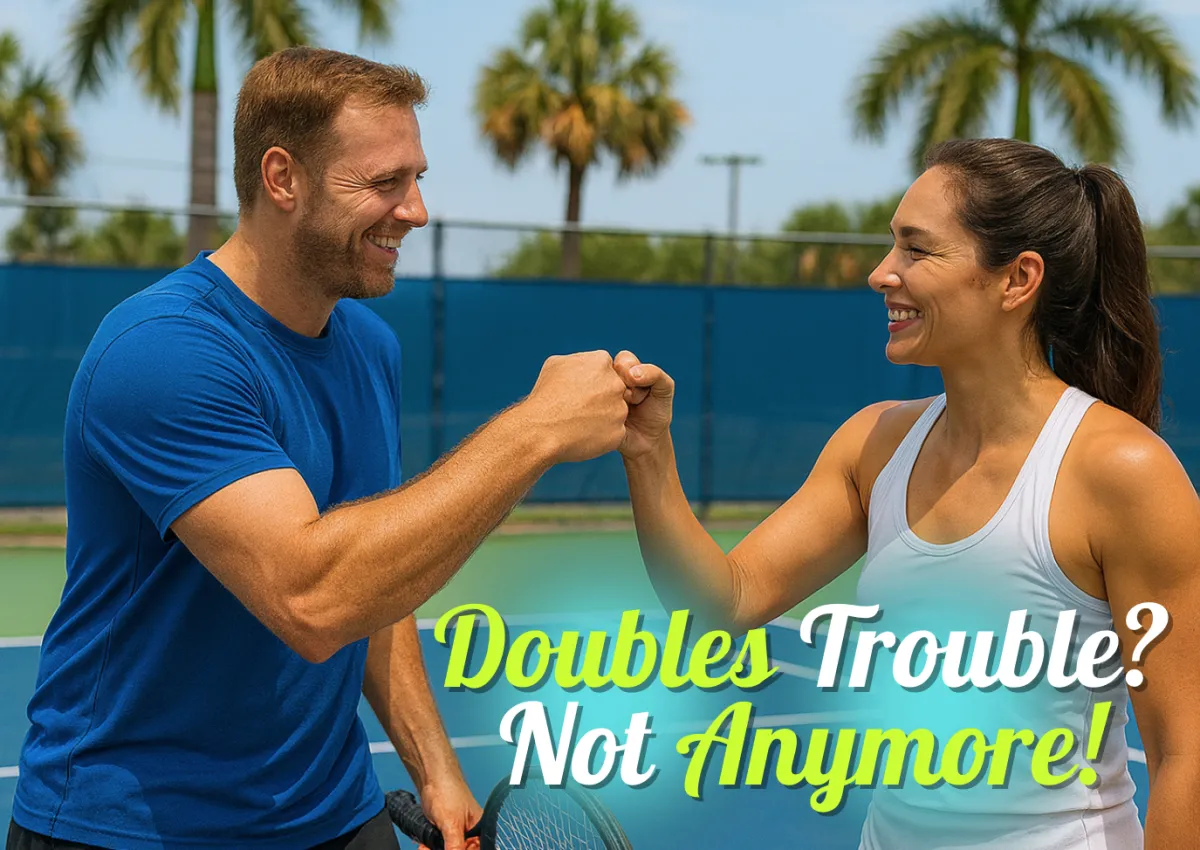TENNIS
TIPS
News/Events

Real Talk and Strategies for Playing Mixed Doubles
Quick Takeaways 📝
Holding serve is non-negotiable — lose it and the set is probably gone.
Free points (especially double faults) are fatal.
Targeting is real, but it can be flipped into an advantage.
Breaking serve is often the turning point in a match.
Communication and trust always outlast ego and raw power.
Serving order and court sides should fit your strengths, not tradition.
Mixed doubles is about patterns and pressure, not “who’s stronger.”
Couples playing together face unique challenges — and sometimes, pitfalls.
💥 Why Mixed Doubles Feels Different
Mixed doubles isn’t men’s doubles with women slotted in. It’s an entirely different animal.
The rules are the same, sure. But the feel of the match? The psychology, the expectations, the way rallies play out? Totally different. You sense it right away the moment you step on court.
For starters, men often feel a subtle (or not-so-subtle) pressure to “carry the team.” That pressure can be self-inflicted, or it can come from opponents who play into stereotypes. Women, meanwhile, walk on court expecting to get more balls — especially on returns and in longer rallies. And the opposing pair usually leans into the same tired formula: “test the woman, fear the man.”
That mix creates tension before the first ball is even struck. But here’s the truth: the best mixed teams don’t resist the format — they lean into it. They accept the quirks, play smart, and flip assumptions into advantages.
At clubs like the H-E-B Tennis Center in Harlingen, you see this every week. On paper, the “strongest” pair doesn’t always win. The winners are usually the ones who talk, who trust, and who are willing to try strategies that fit them instead of falling back on stale habits.
🎯 Serving: Hold or Go Home
If there’s one non-negotiable in mixed, it’s this: you must hold serve. Losing serve doesn’t just cost you a game — it can wreck the entire set.
Think about it. In same-gender doubles, there are chances to claw back. In mixed, not so much. Once you drop your serve, it often sets the tone and creates a hole that’s tough to climb out of.
Myth: “The man should always serve first.”
This is one of those stubborn ideas that just won’t die. The logic seems obvious: the man is “stronger,” so he should start and set the tone. But in reality? It’s often the wrong call.
Sometimes the woman’s serve is more reliable. Sometimes her spin or placement is trickier. Sometimes opponents are caught off guard when she opens the match. The truth is simple: decide based on who actually holds more often. That’s it.
How to Protect Your Serve
Holding isn’t about hitting bombs. It’s about percentages and teamwork. A 70% first-serve rate with safe, placed deliveries beats a handful of aces followed by a bunch of doubles. Placement matters more than speed — jamming the returner’s body or pulling them wide is far more effective than a 110 mph serve that only lands half the time.
And don’t forget: serving is not a solo act. The partner at net is just as responsible. Fake moves, aggressive positioning, and poaches put pressure on the returner and create errors. A great service game in mixed doubles is a team effort, not a solo showcase.
The Golden Rule
If you take nothing else from this: don’t double fault. It’s fatal in mixed. Not only do you give away free points, but you also feed into the assumption that “her serve is weaker” or “his nerves cracked.” If you have to roll in a soft serve to avoid it, do it. The cost of a freebie is simply too high.
👀 The Truth About Targeting
Let’s address the elephant on the court: women get targeted more. Returns, rallies, lobs — it’s the most common mixed strategy in the book.
At first, that feels unfair. But here’s the twist: being targeted can actually be an advantage.
When you see more balls, you warm up faster. You find rhythm. You get comfortable in the flow of the match while your opponents grow impatient waiting for opportunities. Before long, the so-called “target” becomes the one controlling the pace.
The problem is when the male partner panics. Too many men think they have to “rescue” their partner by poaching every ball or stepping in too soon. That smothers rhythm, creates tension, and usually leads to errors. The smarter play? Trust her. Encourage her. Let her build confidence and be ready to pounce when the right ball comes — not every ball.
Mixed doubles isn’t about hiding one partner. It’s about trusting both players to do their jobs.
🔑 Breaking Serve: Where Matches Swing
If holding keeps you alive, breaking serve wins you the match.
In mixed doubles, break chances often pop up when the woman serves — not because she’s weak, but because opponents stack their strongest man at net and pressure every ball. That doesn’t mean her games are doomed. It just means the pair needs sharper tactics.
Serving Team Adjustments
Vary spin and placement. Kick high, slice wide, or jam the body. Don’t be predictable.
Use I-formation or Australian setups. Force returners to adjust and second-guess.
Keep the net partner active. Even fake moves plant doubt in the returner’s mind.
Returning Team Adjustments
Be ruthless on second serves. Step in and swing, no hesitation.
Avoid floaters crosscourt — those are poacher candy.
Mix in lobs to keep the net monster honest.
One break is often enough to tilt a set. That’s why seasoned players treat break opportunities like gold.
⚡ Myths That Refuse to Die
Mixed doubles is loaded with “rules” that aren’t rules at all. Here are the big ones:
Myth 1: The man should always serve first.
False. Serve order is about consistency, not gender.
Myth 2: The man should always play ad court.
False. Sides should match returns. If she has the steadier backhand return, she belongs in ad.
Myth 3: The man has to dominate every point.
False. Overplaying kills chemistry. Mixed is about patterns, not one-man heroics.
Myth 4: Mixed is lighthearted.
False. Sure, it can be fun and social, but in leagues and tournaments, it’s fierce. Pretend otherwise and you’ll get burned.
🧠 Strategies That Actually Work
From both experience and the transcript, here’s the real mixed doubles playbook:
Protect your serve. Placement > power.
Attack second serves. Step in with intent.
Stay alive at net. Fake moves count.
Use the lob smartly. Reset points and frustrate net monsters.
Change formations. Don’t be predictable.
Cut the freebies. Mixed punishes errors faster than any other format.
❤️ Couples in Mixed Doubles: Why Many Avoid It
Here’s a truth most people know but don’t say: a lot of married couples won’t partner up in mixed.
Mixed already tests patience and egos. Add marriage, and every mistake suddenly feels personal. A double fault isn’t just a point lost — it’s an icy silence in the car. A missed volley isn’t just a miss — it’s “you always do that.”
That’s why you see so many couples happily playing with other partners. It preserves harmony at home while still letting them enjoy league night.
❤️ Love & Mixed Doubles: Playing With Your Spouse
Still, some couples do take the plunge — and thrive. For them, mixed doubles becomes a kind of date night with a scoreboard. They laugh at shanks, fist bump through mistakes, and treat the court as an extension of their partnership.
The difference comes down to perspective. Couples who succeed at mixed doubles share three traits:
Perspective 🎯: They remember tennis is a game, not a referendum on their marriage.
Communication 🗣️: They talk through tactics calmly instead of turning coaching into criticism.
Forgiveness ❤️: A mistake is just a mistake — not a character flaw.
If you and your spouse want to try mixed together, set the tone early. Agree that home is home and tennis is tennis. Celebrate effort more than results. And decide beforehand whether you’re there to compete or just have fun.
And if it doesn’t work? No shame in that. Sometimes the healthiest thing for your marriage is not playing together — and saving the stories for dinner instead of dragging frustrations home.
😂 Ego vs. Trust
Mixed doubles exposes egos faster than any other format.
If one partner feels like they’re carrying, resentment creeps in. If the other apologizes too much, confidence drains away. Soon, you’re two individuals sharing a court instead of a team fighting for points.
The solution is trust. Clap for effort. Celebrate small wins. Laugh off the ugly misses. Teams with genuine trust almost always outlast “better” pairs that self-destruct under pressure.
🎬 Common Match Scenarios
The podcast transcript nailed this part, and it’s where most players really learn:
Scenario 1: Strong man + weaker woman
The woman doesn’t need to play hero — she just needs to stay solid, keep returns deep, and force the other guy to hit. The man’s job is patience: set her up, don’t blast through both opponents.
Scenario 2: Strong woman + weaker man
This one flips the script. The strong woman should own it — take the ad court if her backhand is strong, step in on returns, and lead. The weaker man just needs to be steady — keep balls in play, hold serve, and support her strengths.
Scenario 3: You’re being targeted
Don’t panic. Embrace it. More balls means more rhythm. Stay steady and remember: they’re targeting you because they don’t want to face your partner. That’s respect disguised as pressure.
Scenario 4: The net monster
Every league has one — the guy who camps at net and poaches everything. Solution: don’t feed him. Hit behind him, lob him, or jam him with body serves until he cools off.
Scenario 5: Serving nerves
If your partner’s serve is shaky, the net player has to take charge. Poach more. Cross-signal. Encourage safe body serves. Serving becomes a two-person effort.
Scenario 6: Passive partner syndrome
If one player disappears, rallies collapse. The fix? Get them involved early. Encourage them to take net. Make them feel valuable. Nothing kills chemistry faster than one partner going invisible.
🌟 Final Word
Mixed doubles is brutally honest. You have to hold serve. You can’t hand out free points. You need to trust your partner, accept targeting, and seize break opportunities when they appear.
But when you drop the myths, ditch the ego, and lean into your real strengths, mixed doubles transforms into one of the most creative, unpredictable, and rewarding formats in tennis.
📍 Where to Put it Into Practice
If you’re in the Valley, the H-E-B Tennis Center at Pendleton Park in Harlingen is the best place to experience this for yourself. Leagues, clinics, and lessons all bring these dynamics to life, week after week.
If you’re not local? The advice holds anywhere. Grab a partner, step onto a court, and embrace the quirks of mixed doubles. You’ll come away not just a better player — but a better teammate in every sense of the word.


Facebook
Instagram